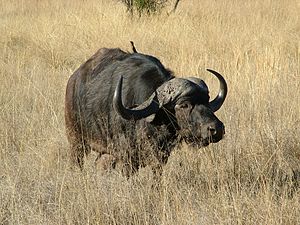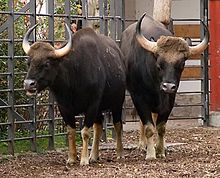Bovine
| Bovine | ||||||||||||
|---|---|---|---|---|---|---|---|---|---|---|---|---|

Cape buffalo ( Syncerus caffer ) |
||||||||||||
| Systematics | ||||||||||||
|
||||||||||||
| Scientific name | ||||||||||||
| Bovini | ||||||||||||
| Gray , 1821 |

The cattle (Bovini) are a generic group of horned bearers (Bovidae). They are large and stocky animals, some species of which play an important role as farm animals , above all domestic cattle . Some types of cattle are also called " buffalo ", this is an arbitrary name that has no systematic relevance.
features
Cattle reach a head body length of 1.60 m to 3.50 m, plus a tail up to 1.00 m long. The shoulder height varies from 0.70 m to 2.00 m, the weight from 150 kg to over 1000 kg (Spanish "fighting bulls" around 500 kg). These animals have a stocky trunk with strong limbs. The fur is usually colored in gray, brown or black tones, the length and texture varies depending on the habitat. Both sexes have horns, but those of the females are smaller and thinner. The horns , unlike those of many other horn-bearers, are smooth. Like all ruminants , they have a multi-chambered stomach, which enables them to use plant food that is difficult to digest.
Distribution and way of life
The original range of the cattle included North America , Eurasia and Africa . They inhabit a number of habitats, but prefer predominantly open wooded areas and grasslands. They usually live together in herds of different social structures and are herbivores.
Cattle and humans
At least five species of cattle, aurochs , banteng , gaur , yak and water buffalo were domesticated ; In particular, the Middle Eastern aurochs in their domesticated form as domestic cattle and the water buffalo have achieved a worldwide distribution and are found in feral populations even in regions that were originally not home to cattle. In contrast, most wild species are threatened. The aurochs became extinct in the 17th century, the Kouprey probably in the 1980s. The Tamarau is listed as critically endangered by the IUCN , and many other species are listed as endangered.
Systematics
In terms of tribal history, the cattle are a relatively young group. The earliest cattle are only known to be fossilized in the Pliocene . They presumably spread from Asia to Europe, North America and Africa. They were particularly rich in species in the Pleistocene .

In the narrower sense used here, cattle comprise three genera with a total of 17 species, two of which are recently extinct:
- Tribus Bovini Gray , 1821 ( cattle )
-
- Genus Actual Cattle ( Bos Linnaeus , 1758)
- American bison ( Bos bison Linnaeus , 1758; also bison bison )
- Wisent ( Bos bonasus Linnaeus , 1758; also Bison bonasus )
- † Bergwisent ( Bos caucasicus Satunin , 1904; also Bison caucasicus )
- Gaur ( Bos gaurus C. H. Smith , 1827); from this species the Gayal ( Bos frontalis ) was domesticated
- Banteng ( Bos javanicus d'Alton , 1823); the Balirind was domesticated from this species
- Yak ( Bos mutus Przewalski , 1883); from this species the domestic animal form Bos grunniens was domesticated
- † Aurochs ( Bos primigenius Bojanus , 1827); from this species the domestic cattle ( Bos taurus ) and the zebu ( Bos indicus ) were domesticated
- Kouprey ( Bos sauveli Urbain , 1937); this species is probably extinct
- Genus Asiatic Buffalo ( Bubalus C. H. Smith , 1827)
- Water buffalo or arni ( Bubalus arnee ( Kerr , 1792)); from this species the pet form Bubalus bubalis was domesticated
- Lowland anoa or anoa ( Bubalus depressicornis ( CH Smith , 1827))
- Tamarau or Mindoro Buffalo ( Bubalus mindorensis Heude , 1888)
- Mountain anoa ( Bubalus quarlesi ( Ouwens , 1910)); the species is not generally recognized and is usually listed together with the lowland anoa
- Genus Syncerus Hodgson , 1847
- Sudan buffalo ( Syncerus brachyceros ( Gray , 1837))
- Cape buffalo ( Syncerus caffer ( Sparrman , 1779))
- Virunga buffalo ( Syncerus matthewsi Lydekker , 1904)
- Red buffalo ( Syncerus nanus ( Boddaert , 1785))
- Genus Pseudoryx Dung, Giao, Chinh, Tuoc, Arctander & MacKinnon , 1993
- Saola or Vietnamese forest cattle ( Pseudoryx nghetinhensis Dung, Giao, Chinh, Tuoc, Arctander & MacKinnon , 1993)
The delimitation is controversial. The four-horned antelope is sometimes also placed with the cattle, in some cases bison is considered identical to Bos . The Boselaphini and the Tragelaphini are closely related to the Bovini . All three tribes together form the subfamily of the Bovinae within the hornbeam .

Originally the genus bison was separated from the actual cattle ( Bos ) with the American bison ( Bos bison ) and the wisent ( Bos bonasus ) . A molecular genetic study based on mitochondrial DNA published in 2004 , presented by Alexandre Hassanin and Anne Ropiquet, came to a different conclusion ( Bubalus mindorensis and Bubalus quarlesi are not included in this classification). Accordingly, the American bison is more closely related to the yak, while the bison is related to domestic cattle (or aurochs). It should be noted, however, that an examination of mitochondrial DNA only describes matrileneal relationships and thus only a small section of the possible relationships. Investigations of the paternally inherited Y chromosomes (also only describing a small section of the possible relationships) support the classic system with the division into the genera Bos and Bison . One explanation for these contradicting results of matrilinear and patrilinear phylogenetics is that the modern bison was created by an ingressive cross-breeding of male bison representatives (e.g. steppe wisent Bos priscus ) into a population of Bos cows, which would mean that (a ) prehistoric bison bulls mated with prehistoric Bos cows so that only bison Y chromosomes and Bos mitochondria were passed on, and (b) that the resulting hybrid populations for a sufficient number of generations of offspring exclusively from bison bulls in order to make the phenotype of these hybrid populations indistinguishable from the bison phenotype.
The relationship can be illustrated by the following family tree:
| Bovini |
|
||||||||||||||||||||||||||||||||||||||||||||||||||||||||||||||||||||||||
|
|
Footnotes
- ↑ Colin Groves and Peter Grubb: Ungulate Taxonomy. Johns Hopkins University Press, 2011, pp. 1-317 (pp. 110-124)
- ↑ Colin P. Groves and David M. Leslie Jr .: Family Bovidae (Hollow-horned Ruminants). In: Don E. Wilson and Russell A. Mittermeier (eds.): Handbook of the Mammals of the World. Volume 2: Hooved Mammals. Lynx Edicions, Barcelona 2011, ISBN 978-84-96553-77-4 , pp. 572-588.
- ↑ Alexandre Hassanin and Anne Ropiquet: Molecular phylogeny of the tribe Bovini (Bovidae, Bovinae) and the taxonomic status of the Kouprey, Bos sauveli Urbain 1937. Molecular Phylogenetics and Evolution 33 (3), 2004, pp. 896-907, doi: 10.1016 / j.ympev.2004.08.009 .
- ↑ a b Edward LC Verkaar, Isaac J. Nijman, Maurice Beeke, Eline Hanekamp, John A. Lenstra: Maternal and paternal lineages in cross-breeding bovine species. Has wisent a hybrid origin? Molecular biology and evolution 21 (7), 2004, pp. 1165-1170, doi: 10.1093 / molbev / msh064 .
- ↑ Juan P. Zurano, Felipe M. Magalhães, Ana E. Asato, Gabriel Silva, Claudio J. Bidau, Daniel O. Mesquita and Gabriel C. Costa: Cetartiodactyla: Updating a time-calibrated molecular phylogeny. Molecular Phylogenetics and Evolution 133, 2019, pp. 256-262, doi: 10.1016 / j.ympev.2018.12.015 .
literature
- Colin Groves and Peter Grubb: Ungulate Taxonomy. Johns Hopkins University Press, 2011, pp. 1-317 (pp. 110-124)
- Colin P. Groves and David M. Leslie Jr .: Family Bovidae (Hollow-horned Ruminants). In: Don E. Wilson, Russell A. Mittermeier (eds.): Handbook of the Mammals of the World. Volume 2: Hooved Mammals. Lynx Edicions, Barcelona 2011, ISBN 978-84-96553-77-4 , pp. 572-588
- Don E. Wilson , DeeAnn M. Reeder: Mammal Species of the World . A taxonomic and geographic reference. Johns Hopkins University Press, Baltimore, Md. 2005, ISBN 0-8018-8221-4 (2 vols.)